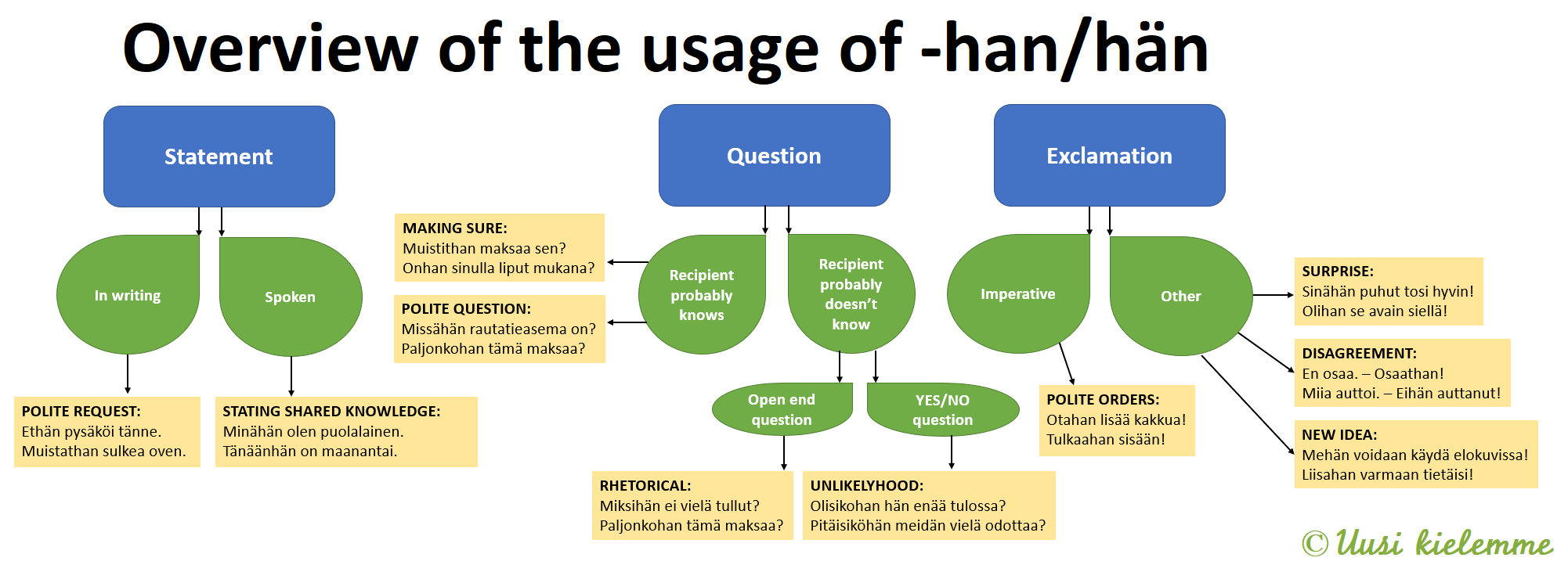-Han/hän – Liitepartikkeli Clitic – Minähän sanoin!
The ending -han/hän is used in many different situations in Finnish. You add this clitic (liitepartikkeli) to the end of a word to give an extra nuance to the general meaning of the sentence. It’s how you can make a sentence carry a little extra meaning than what the words say.
Below, you can find out when to use the suffix -han/hän. This article will be part of a larger series on clitics in Finnish. I will be adding more links to this article as I work my way through all of them.
- The syntax of -han/hän
- Uses of -han/hän in affirmative sentences
- Stating shared knowledge
- In polite (written) requests
- In polite (spoken) orders
- The speaker exclaims in disagreement
- The speaker expresses surprise
- The speaker comes up with a new idea
- Uses of -han/hän in questions
- Making requests more polite
- The speaker is making sure someone remembered
- Making questions rhetorical
- Expressing unlikelihood with questions
1. The syntax of -han/hän
Whether we use -han or -hän depends on vowel harmony (e.g. säärihän vs. saarihan).
The suffix -han will be added to the first word of a sentence. This word can be any wordtype whatsoever: a noun, verb or adverb. We can change the word order of the sentence in order to stress a different word. There are certain limitations to which word orders sound natural, but it’s hard to pinpoint the specifics of this.
| Finnish | English |
|---|---|
| Tänäänhän on maanantai. | Today is Monday, remember? |
| Onhan tänään maanantai. | It is Monday today after all. |
| Minähän rakastan sinua. | You know that I love you. |
| Rakastanhan minä sinua. | You know I love you (don’t hate you). |
| Sinuahan minä rakastan. | You know I love you (nobody else). |
2. Uses of -han/hän in affirmative sentences
2.1. Stating shared knowledge
The liitepartikkeli -han can be used as a gentle way of reminding someone of a fact they should already know. It implies that the information isn’t new to the other person. Because it is a gentle reminder, it’s used to make a sentence a little bit more polite. (And yes, hänhän is actually a word.)
| Finnish | English |
|---|---|
| Tänäänhän on maanantai. | Today is Monday, remember? |
| Suomihan on tasavalta. | Finland is a republic after all. |
| Hänhän on suomalainen. | He is a Finn after all. |
| Kaikkihan niin tekevät! | Everyone does so, after all! |
| Ymmärräthän sinä sen. | Surely you understand. |
| Minähän opiskelin Turussa. | I studied in Turku, remember. |
“Finland is a republic.”
- Without -han: The sentence Suomi on tasavalta means “Finland is a republic”. Without -han, this sentence is simply conveying information; we’re stating a fact.
- With -han: When we say Suomihan on tasavalta we aren’t conveying new information at all. The fact that Finland is a republic is already known to both parties. The speaker is perhaps laying the ground for some new things they will say in their follow-up sentence. They might also be gently reminding you of something you should already know.
“He’s a Finn.”
- Without -han: The sentence Hän on suomalainen means “He’s a Finn”. Without -han, this sentence is conveying new information. We’re telling someone this person’s nationality.
- With -han: When we say Hänhän on suomalainen the speaker is reminding someone of this common knowledge. This could be used, for example, when one person is amazed about how much more social Pekka gets after he’s had a few drinks. The reply could be Hänhän on suomalainen, which functions as an explanation: he is a Finn after all. The speaker is reminding us of information that both people in the conversation already possess.
2.2. In polite (written) requests
If you live in Finland, you will come across signs in shop windows and on doors which include the suffix -han. In these cases, its meaning is very close as in the previous point: they’re a reminder of something that should be common knowledge already.
One important aspect is that this sentence construction doesn’t require a specific recipient. Tulethan could be directed at anyone. That’s why the imperative tule (come!) is used more in spoken language, while tulethan can be seen on notes and signs.
| Finnish | English |
|---|---|
| Varmistathan, että ovi menee lukkoon. | Please make sure that the door locks. |
| Tulethan ajoissa. | Please come on time. |
| Ethän laita pyörääsi ikkunan eteen. | Please don’t put your bike in front of the window. |
| Ethän paiskaa ovea, kiitos (pic)! | Please don’t slam the door! |
| Ethän tule kipeänä parturiin (pic). | Please don’t come to the barber’s while sick. |
| Otathan lisää kakkua. | Surely you are taking more cake? |
“You come on time.”
- Without -han: The sentence Tulet ajoissa is just a statement of a fact. We’re neither demanding nor ordering someone, just telling things the way they are.
- With -han: Tulethan ajoissa carries a hint of the meaning in the previous point: we’re reminding someone of something they should aready know. Adding -han to a verb makes the reminder also a request. It’s much more polite than using an imperative (Tule ajoissa!).
“Don’t put your bike in front of the window.”
- Without -han: If we just say the sentence without -han, we get Et laita pyörääsi ikkunan eteen. This isn’t a request at all, but rather a statement “You don’t put your bike in front of the window”. The imperative Älä laita pyörääsi ikkunan eteen is an order.
- With -han: Ethän laita pyörääsi ikkunan eteen is a polite request. It carries the connotation of “You should already know this and I feel a little ill at ease reminding you, but please don’t put your bike in front of the window.”
“Take more cake.”
- Without -han: Otat lisää kakkua states a fact: you are taking more cake. The imperative form Ota lisää kakkua is an order and can be construed as pressuring someone (usually not though).
- With -han: When there is actually a specific recipient of the request, for example at the coffee table, otathan lisää kakkua is a request to which the speaker adds the meaning of “surely”. They’re assuming that surely you want to take more cake, so please go ahead and take some.
2.3. In polite (spoken) orders
You can also add the suffix -han/hän to an imperative form. This carries the same meaning as the previous point, but requires there to be a recipient present: we’re being polite requesting something of a person present (in contrast with 2.2. where the recipient could be anyone reading). In addition to being polite, it can also be construed as being patient or just friendly. We can add it to both the singular (tule!) and the plural (tulkaa!) imperative.
| Finnish | English |
|---|---|
| Otahan lisää kakkua! | Go ahead and take some more cake! |
| Tulkaahan sisään! | Please come in! |
| Älähän mene mihinkään! | Don’t you go anywhere, okay? |
“Take more cake!”
- Without -han: It’s not impolite to tell someone Ota lisää kakkua in a family setting or with friends. You can definitely say this.
- With -han: Adding the clitic -han will turn orders into requests. It’s politer or more friendly.
“Don’t go anywhere!”
- Without -han: Älä mene mihinkään! “Don’t go anywhere!” is certainly something you can tell someone in your family without being construed as being demanding. However, it is more pressing than Älähän mene mihinkään.
- With -han: Adding the clitic -han will turn orders into requests. It’s politer or more friendly: “Don’t go anywhere, will you?”
2.4. The speaker exclaims in disagreement
When you’re disagreeing with a statement someone puts forth, you can use the -han clitic to disagree with them.
| Finnish | English |
|---|---|
| – Minä en osaa edes laulaa! | – I can’t even sing! |
| – Osaathan sinä! | – Sure you can! |
| – Minä en tule sinun mukaasi. | – I’m not coming with you. |
| – Sinähän tulet, kun minä sanon niin! | – You will come, when I say you will! |
| – Tiina siivosi huoneensa. | – Tiina cleaned her room. |
| – Eihän siivonnut! | – No she didn’t! |
2.5. The speaker expresses surprise
You can also use this liitepartikkeli to express surprise about something. It means that something turned out some way which is contrary to what they were expecting.
| Finnish | English |
|---|---|
| Hyvinhän sinä puhut suomea! | You speak (surprisingly!) good Finnish! |
| Sinähän valehtelit minulle! | Wow, you lied to me! |
| Tuossahan se avain on! | Oh, there that key is! |
2.6. The speaker comes up with a new idea
When you’re presenting a new idea that you just thought of, you can also add -han to the first word of the sentence. This is most commonly used in combination with the conditional tense, but this is not 100% necessary.
| Finnish | English |
|---|---|
| Mattihan osaisi varmaan auttaa! | Hey, Matti could probably help! |
| Mehän voitaisiin käydä piknikillä! | Hey, we could go on a picnic! |
| Tehän voisitte tulla vaikka heti! | Hey, maybe you could come right away! |
3. Uses of -han/hän in questions
3.1. Making requests more polite
The suffix -han/hän is especially common in questions where you’re asking for help or advice. It gives a more friendly impression. The difference is pretty small. Finnish doesn’t have a word for “please”, but the -han particle can often convey the same meaning when added to a question.
The question can be both conjugated in the conditional or not, depending on how much politeness you want to add to the question.
| Finnish | English |
|---|---|
| Osaatkohan sanoa, missä posti on? | Would you be able to say where the post office is? |
| Avaisitkohan oven minulle? | Could you please open the door for me? |
| Olisikohan sinulla aikaa katsoa tätä? | Do you think you would have some time to look at this? |
| Paljonkohan tämä maksaa? | How much does this cost, please? |
| Onkohan toimitusjohtaja tavattavissa? | Is it possible to meet the CEO, please? |
| Olisikohan toimitusjohtaja tavattavissa? | Would it be possible to meet the CEO, please? |
“Could you open the door for me?”
- Without -han: Avaisitko oven minulle? “Could you open the door for me?”
- With -han: Avaisitkohan oven minulle? “Could you please open the door for me?”
“Would you have the time to look at this?”
- Without -han: Olisiko sinulla aikaa katsoa tätä? “Would you have some time to look at this?”
- With -han: Olisikohan sinulla aikaa katsoa tätä? “Do you think you would have some time to look at this? It’s okay if you don’t, I understand, but I’d be grateful”. I’m kind of exaggerating with this translation, but that’s the general idea.
“Is it possible to meet the CEO?”
- Without -han: Onko toimitusjohtaja tavattavissa? is a regular question which is a request for information, presented to, for example, the receptionist. It can be construed as a little impolite, but it doesn’t inherently carry that meaning.
- With -han: Onkohan toimitusjohtaja tavattavissa? is a more polite question, adding the essense of the English word “please” to the question: “Would it be possible for me to meet the CEO, please?
- With the conditional: Olisikohan toimitusjohtaja tavattavissa? is very polite when you’re asking the receptionist. You’re expecting the receptionist to know, but you’re making it very clear that you’re in no way demanding to meet the CEO right there and then.
3.2. The speaker is making sure someone remembered
In situations where you just want to make sure that someone has remembered something, the -han clitic is also very useful.
| Finnish | English |
|---|---|
| Onhan sinulla ne liput? | You do have the tickets, right? |
| Ostithan kananmunia? | You did buy eggs, didn’t you? |
| Ymmärräthän kaiken? | You do understand everything, right? |
3.3. Making questions rhetorical
These sentences are the hardest to translate because they can carry multiple other meanings, depending on who you’re talking to. When -han is added to questions that don’t request help or advice, it often makes a question rhetorical.
This requires that you’re talking to someone who doesn’t know either. We’re not assuming that the other person knows the answer. It’s kind of a way to express that both you and the other person don’t know the answer to the question.
| Finnish | English |
|---|---|
| Miksihän hän ei ole vielä tullut? | I wonder why he hasn’t come yet. |
| Ovatkohan he vihaisia meille? | (Do you think) they’re angry at us? |
| Onkohan siellä paljon ihmisiä? | (Do you think) there will be many people there? |
| Paljonkohan tämä maksaisi? | How much do you think this would cost? |
3.4. Expressing unlikelihood with questions
When talking to someone who doesn’t know either, a conditional sentence can express that something isn’t very likely. I’m translating these questions very loosely in the table below using the negative. In Finnish, they’re not negative questions, but it’s easier to compactly convey the same meaning by changing the whole sentence up when translating.
| Finnish | English |
|---|---|
| Olisikohan hän vielä tulossa? | He probably won’t be coming anymore, right? |
| Sataisikohan tänään lunta? | I guess it won’t be snowing today, right? |
| Mahtuisikohan tämä pakastimeen? | I wonder if this would fit in the freezer. |
Read more elsewhere about -han/hän
I’ve glanced over some details and peculiarities of this issue in the article. Further articles might dive deeper into these details. For now, you can read more from the following sources:
- VISK: Overview of articles that deal with clitics
- Valtioneuvoston kanslia: -HAN, -HÄN




